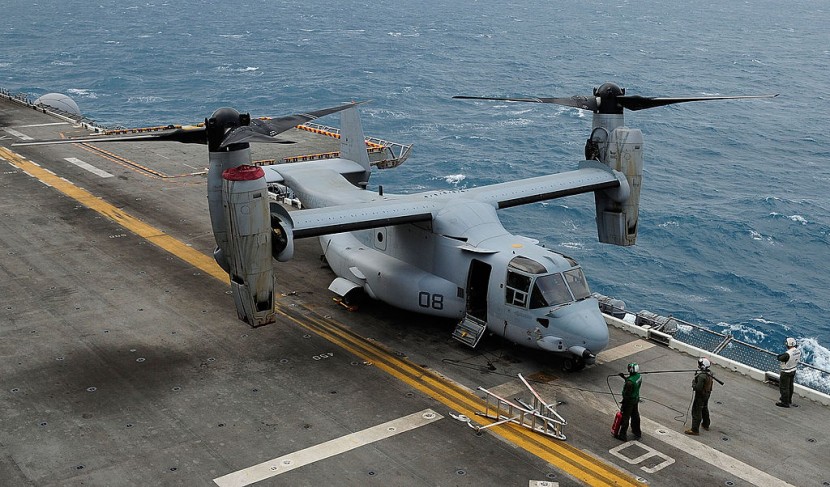
The V-22 Osprey Tilt-Rotor Aircraft is one of the latest rotorcrafts with no tail rotor. Instead, it has two sizeable adjustable angling rotors mounted on two wings.
V-22 Tilt-Rotor Aircraft, Bell's amazing helicopter
The V-22 Osprey was developed by Boeing and Bell Helicopters on contract with the US military to produce a new, non-traditional kind of helicopter, as reported by Airforce Technology.
Boeing and Bell Helicopter Textron manufacture most components such as the aircraft body, landing gear, flight controls, including the avionics, electrical and hydraulic systems, and finally, the testing of the flying and performance of the helicopter. Bell's other parts are the crucial wing and housing for engines/rotor system, tail system, entry ramp, wing structure, and dynamics.
#USNavy photos of the day: #USSHarrySTruman #fltops in #US5thFleet, #USSTheodoreRoosevelt and #USSAmerica transit #US7thFleet, #USMC #MV22 lands aboard #USSTheodoreRoosevelt and #RecruitTrainingCommand march in the snow.⬇️ info & download ⬇️: https://t.co/tGpVcer9TI pic.twitter.com/3uG7raGNhd
— U.S. Navy (@USNavy) February 19, 2020
V-22s are in service with the US Marines, US Navy, and Japan. Its 400th unit was delivered to the US Air Force (USAF) Special Operations Command in June 2020.
But what can it do?
Essentially it is a combination of an airplane and a helicopter, and it can hover and set down vertical on any landing strip or carrier deck. When it has reached a certain height, the engine house will make a 90-degree adjustment to face the rotor forward, like a plane for level flight.
It is designed for VTOL (vertical take-off and landing) carrying 24-troops, more than double the 11 of the UH-60 Black Hawk. It also has a carrying capacity of 6 tons with a combat range of 430 nautical miles. However, if the load is 8 tons plus, the range drops to only 220 nautical miles.
The V-22 can deploy anywhere and has a max of 2,100 nautical miles with extra fuel, but only 1,100 nautical miles at standard capacity.
There are several loadouts and variants used for the Osprey. The Combat Assault and Assault Support (Marines/Army) for long-range missions, the US Special Operations Command (US SOCOM), US Navy HV-22 combat search and rescue, special warfare, and fleet logistic support.
The tilt-rotor system is compact with folding blades and wings for storage on most navy L-class amphibious ships. It boasts LHD/LHD light carriers, and Nimitz class aircraft carriers.
Weapon systems
The tilt-rotorcraft may look fancy, but it also carries a lot of firepower. It has an M240G, 7.62mm machine gun stationed at the rear loading ramp.
BAE Systems in 2008 got the contract from the US SOCOM to design and install an auto turret on the Osprey based on the remote guardian system (RGS), which fires in a 360-degree arc. It also has guns on the belly of the aircraft with a GAU-17 7.62mm minigun. This is one of its major armaments for now.
Blazing fast level flight
One unit has a climbing rate of 16.2m/s in maneuvers, with a maximum speed of 565km/h and 510km/h, with a typical range of 3,379km. In kilometers, the actual combat range and service limit are 692km and 7,620m, respectively.
To help the V-22 Osprey Tilt-Rotor Aircraft navigate and see its surroundings, it has a Raytheon AN/APQ-186 terrain-following, multimode radar for high speed and low altitude flight. At night it can see with Raytheon AN/AAQ-16 (V-22) FLIR night vision systems that allow high-speed insertion at night.
Related article : Futuristic 'Defiant X' Flies to Be the Next Generation Long-Range Assault Helicopter of the US Army








